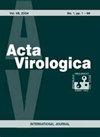四种主要手足口病相关肠道病毒的基因组系统发育分析。
IF 0.8
4区 医学
Q4 VIROLOGY
引用次数: 0
摘要
肠病毒已经分化成许多类型,其中一些会导致儿童手足口病。与手足口病相关的主要肠道病毒类型为EVA71、CVA16、CVA6和CVA10。根据VP1序列将4种肠道病毒分为不同的亚型。然而,这些肠道病毒的系统发育很少在基因组水平上得到关注。在这项研究中,我们利用现有的全基因组序列对EVA71、CVA16、CVA6和CVA10进行了系统发育分析。研究发现,除了EVA71和CVA10的少数亚型外,VP1全长基因组序列与VP1序列的系统发育树拓扑结构基本一致。亚型间遗传差异均值为15.8 ~ 27%,亚型/亚亚型间遗传差异均值小于12%。通过比较基因组序列和VP1序列的系统发育拓扑结构,我们鉴定出两个新的EVA71亚型间重组基因RF01_CC4和RF02_CC4。此外,发现EVA71亚型C1和C2以及CVA10亚型D是通过亚型间重组产生的。这里提供了这些肠道病毒的基因组参考序列用于分型。这些结果为了解这四种肠道病毒的进化和流行病学提供了重要的见解。关键词:肠病毒;手;口蹄疫;分类;遗传距离;重组。本文章由计算机程序翻译,如有差异,请以英文原文为准。
Genomic phylogenetic analyses of four major hand, foot and mouth disease-related enteroviruses.
Enteroviruses had diverged into many types, some of which cause hand, foot and mouth disease (HFMD) in children. The predominant enterovirus types associated with HFMD are EVA71, CVA16, CVA6 and CVA10. Four enterovirus types were classified into subtypes based on VP1 sequences. However, the phylogenetics of these enteroviruses is rarely concerned at the genomic level. In this study, we performed the phylogenetic analyses of the EVA71, CVA16, CVA6 and CVA10 using available full-length genomic sequences. We found that the topologies of phylogenetic trees of full-length genomic sequences and VP1 sequences were almost consistent, except few subtypes of EVA71 and CVA10. The mean genetic divergence was 15.8-27% between subtypes and less than 12% within subtypes/sub-subtypes at genomic level. Comparison of phylogenetic topologies between genomic and VP1 sequences helped us to identify two new EVA71 inter-subtype recombinants RF01_CC4 and RF02_CC4. Furthermore, EVA71 subtypes C1 and C2 and CVA10 subtype D were found to originate through inter-subtype recombination. The genomic reference sequences of these enteroviruses are provided here for subtyping. The results provide important insights into the understanding of the evolution and epidemiology of the four enteroviruses. Keywords: enterovirus; hand; foot and mouth disease; classification; genetic distance; recombination.
求助全文
通过发布文献求助,成功后即可免费获取论文全文。
去求助
来源期刊

Acta virologica
医学-病毒学
CiteScore
3.10
自引率
11.80%
发文量
43
审稿时长
>12 weeks
期刊介绍:
Acta virologica is an international journal of predominantly molecular and cellular virology. Acta virologica aims to publish papers reporting original results of fundamental and applied research mainly on human, animal and plant viruses at cellular and molecular level. As a matter of tradition, also rickettsiae are included. Areas of interest are virus structure and morphology, molecular biology of virus-cell interactions, molecular genetics of viruses, pathogenesis of viral diseases, viral immunology, vaccines, antiviral drugs and viral diagnostics.
 求助内容:
求助内容: 应助结果提醒方式:
应助结果提醒方式:


